by The History Chicks | Nov 5, 2011 | Biography Episode, Episode, Podcasts
It was a dark and stormy night. Three friends sat around the fire taking turns reading German ghost stories…
No, really. It was. Ok, maybe that night wasn’t stormy, but it was a summer night in 1816, when a then 18 year- old Mary Wollstonecraft Godwin Shelley, and the poets Percy Bysshe Shelley and Lord Byron were sitting around a fire at Lake Geneva. It was here that the three challenged each other to write the scariest story they could, Mary’s contribution would become her first published work and a tale so creepy that it would endure to present time, and beyond: Frankenstein: or the Modern Prometheus.
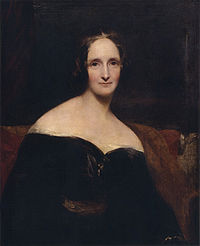
Mary Shelley, by Richard Rothwell
In this mini-cast we take a little time to look at the life before, and after, Mary Shelley wrote her most famous book.
The story of Mary Shelley begins ten days before her mother, Mary Wollstonecraft, dies.
How is that for a dramatic entrance?
Born on August 30th, 1797, she was the first and only love child of writers Mary Wollstonecraft and William Godwin. (For the details on this woman, please give a listen to our podcast on Mary Wollstonecraft). Her mother had a young daughter from another relationship, Fanny Imlay, who was to be raised by now single dad Godwin with his own daughter- Mary Wollstonecraft Godwin…not to be confused with his wife, Mary Wollstoncraft Godwin. (Susan puts down her head and weeps…why must you people name your children the same name as you have!?)
When Mary was four, her father remarried Mary Jane Clairmont who brought two children, Charles and Claire into the home. William was a pretty involved father, and while Claire was sent off to school, Mary was pretty much educated at home. But being educated at home by an intellectual who ran in some pretty cool circles- as well as encouraging you to read all the writings of your mother-isn’t exactly a lacking education.
By now you should know that we love to get into the more, er, gossipy side of women’s lives. And Mary Shelley gave us a bit to look at. As a young teen she meets Percy Shelley. MARRIED Percy Shelley. He falls for her while studying at the feet of her father. And helping to pay his bills. At one point, Daddy says “stay away from my daughter”, but that’s not to happen.

Pretty boy-Percy Shelley
At 17, Mary runs off with Percy, taking her step-sister Claire with them.
Oh! This is a road trip for the ages! We do go into it in detail in the podcast, but by the time a penniless Percy and Mary come back to England she is pregnant, and his wife is pregnant. Harriet Shelley gives birth to a son, and Mary gives birth to a premature daughter, who dies shortly after birth.

So sad! Right before little William's death in 1819
We do tell you all about Mary’s five pregnancies, and the one child who lives to adulthood. About the death of Percy’s wife, the marriage of Mary and Percy, and the travels of the trio of Percy, Mary and Claire and their children. We chat about the creation of Frankenstein, Lord Byron, and the death of Percy.
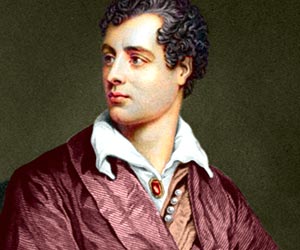
Lord Byron...(yeah, we don't get into THAT much detail)
This may be a mini-cast but it is full of drama! What a life this woman created and lived!
After Percy’s death, Mary’s life settles down somewhat. She is a writer, but never sees success to the likes of Frankenstein- which in our opinion- makes her quite a writer indeed.
The end of Mary Wollstonecraft Godwin Shelley’s life was full of illness and living with her remaining son*sigh* Percy. She died of a brain tumor in 1851 at the age of 54.
Time Travel with The History Chicks
We admit, this was a minicast about the full life of a woman who did a lot of living in her years. Here is a great starting place to look a bit more into the life of Mary Shelley, and there are other posts about her on this site as well: http://www.poetryfoundation.org/bio/mary-wollstonecraft-shelley
Just because we thought it was an interesting look at the beginnings of Frankenstein: http://www.guardian.co.uk/books/2011/sep/26/frankenstein-hour-creation-identified-astronomers
And we really liked this book:
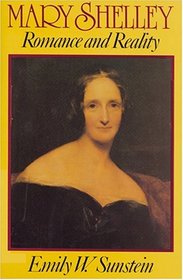
Mary Shelley: Romance and Reality, by Emily Sunstein
Go, read Frankenstein! Read the graphic novel! Watch the movies! Enjoy! It’s a classic!

1931 with Boris Karloff

heh heh...
by The History Chicks | Oct 23, 2011 | Biography Episode, Episode, Podcasts
Imagine that you had ideas that were so radical for your time that it would take a couple of hundred years for them to be accepted? Can you imagine that your lifestyle would be given more attention in those years than your message? Can you imagine that your most important work was often mispronounced?
Such was the life of the woman we spoke of this week, Mary Wollstonecraft.
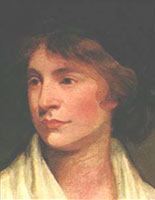
Born April 27th, 1759 in London, as the second of seven children to Edward and Elizabeth. Her birth station in life was one of upper middle class. However her father pretty much squandered his inheritance, and the family moved frequently. Each time they did it was a step down to a less affluent home. Dad was a drinker, and pretty abusive…it really wasn’t a warm and happy childhood.
Mary had a couple of close friends as well as some neighbors who cared for her, helped her with her education as well as providing bright spots in a pretty bleak life. Her future prospects didn’t seem very promising.
For an unmarried woman of her time and social class she took up pretty much every career that was available to her.
Lady’s Companion?
Fail.
School Teacher?
Good…for a bit.
Governess?
Not so great.
Of course we go into more detail in the podcast, but she left home at 19 to try and make a living. She supported her sister Eliza, who she helped leave a possibly abusive marriage. She tried to also hang out as long as possible with her friend, Fanny Blood- but conventional lifestyles were not really her thing and they were very much Fanny’s thing.
“I am not born to tread in the beaten track – the peculiar bent of my nature pushes me on.” Mary Wollstonecraft wrote to her other sister, the cooler named Everina.
She got that right.
Finally she ends up in London, working for a man named Joseph Johnson, a book publisher. He encourages her in her writing, and write she did. Children’s books, reviews , and her first novel – entitled Mary- a fiction, which was based on her travels to Portugal to attend the birth- and unexpected death- of Fanny Blood and her first child.
She wrote a book about what she learned as the head of a school, and as a Governess, with the lengthy title, “Education of Daughters: With Reflections on Female Conduct in the More Important Duties of Life.”
Got that?
She also established herself as a political writer with the publication of The Vindication of the Rights of Men, which was a rebuttal of piece written by Edmund Burke.
And on the heels of that document she wrote the biggie: A Vindication of the Rights of Woman: With Strictures on Political and Moral Subjects. Did you catch that? ” WOMAN” Not “womEn” as is often mistaken. Even in this podcast. *coughbySusancough*
What is it about? Well, ENTIRE college level courses are devoted to this work, so we can’t sum it up here. But try this version:
-Women are only inferior due to their inferior education
-All minds are equally receptive to knowledge no matter what package they arrive in
-Women ought not to have power over men, but over THEMSELVES.
(Plus 449 more pages of important information)
While she was starting to grow in both works and audiences as a writer, her personal life was a mess.
She fell in love with artist Henry Fuseli and went so far as to ask his wife if they can all live under one roof. Yeah. That went over well. (No, it really didn’t).
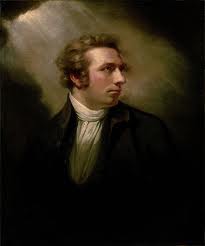
Then she falls in love with American Gilbert Imlay. This relationship produces a daughter, Fanny, as well as a lot of scandal. Imlay claims her as his wife while they are in France ( just watching the French Revolution), although they are not legally married. Mary settles into life as a mother, but Imlay didn’t sign up for such domesticity and is gone for longer and longer times. yadda yadda…two suicide attempts and a business trip to Scandinavia later- he moves in with another woman.
Mary, Mary, Mary…sigh…

Enter William Godwin. The two had traveled in similar social circles in London before life mellowed out Mary. He fell in love with her through her writing and finally they see eye to eye ( as well as other body parts) and begin a fast romantic relationship. He gets her, she gets him, they get pregnant and married.
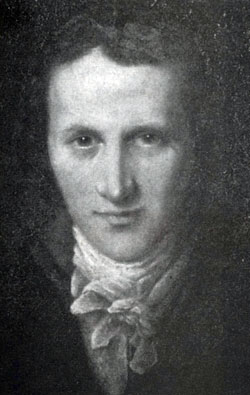
The end.
Ok, not quite…she gives birth just a mere year after their romance for the ages begins. Ten days after the arrival of baby Mary Godwin, Mary Wollstonecraft dies from complications after childbirth. This left the love of her life to raise her two daughters, Fanny and Mary–who will grow to become Mary Shelley, author of Frankenstein.
And just because you don’t think that this story can’t get any more tragic: In an act of deep mourning and love Godwin publishes her letters in an attempt to show the world what a remarkable and special woman she was. Memoirs of the Author of A Vindication of the Rights of Woman. With this book, all the details of her private life are revealed and her reputation is trashed for a couple hundred years.
Ouch.
Time Travel With The History Chicks
You can read A Vindication of the Rights of Woman. Or you can listen to it – Librivox has it for free on itunes.
We know, you want to read the one that trashed her reputation…naughty listener! 18 bucks on Amazon or download it to your Kindle free!
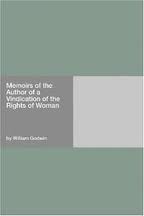
The letters of Mary Wollstonecraft are available in many different books, as are a good number of her works.
The Collected Letters of Mary Wollstonecraft compiles a great number of her letters.

And you REALLY want to watch this, we know you do.
http://www.youtube.com/watch?v=qjalBmkmkvE
And now that you are really into the life of this woman, check out this blog, or follow Mary on Twitter ( we kid you not!) http://avindicationoftherightsofmary.blogspot.com/p/mary.html
****CORRECTION! Sharp listener Jacki caught a slight faux pas in our Drop Into History segment! George Washington’s wife’s maiden name was Custis, not Curtis. Sorry for the error!*********
As always, music comes courtesy of Music Alley, music.mevio.com
by The History Chicks | Oct 13, 2011 | News
We recently received news that we had been nominated for a 2011 People’s Choice Podcast Award in the Education category! How did we react to this news?
First- we were shocked.
And then we looked at the amazing podcasts that share the Education category, and we were stunned.
Then we were delighted.
Our delight stems from the fact that you, our listeners, voted to put us up for this award. THANK YOU!!!
Now we would like to ask for your vote.
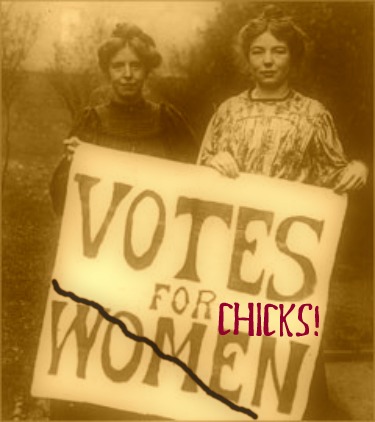
We do not think of "chicks" as derogatory. We think we rock our chick-ness!
Please click this link http://podcastawards.com/ to do just that. While you are there, vote for your other favorite podcasts just like we will be doing every day until October 27th when voting ends! The Bowery Boys are facing some Disney competition in the Travel category; and Filmsack is up for best Movie/Film podcast..it’s all very exciting and we are thrilled to be a part of it.
Thank you, again, for listening, offering topic suggestions, dropping us notes of encouragement, and for helping us become nominated for this award.
Now what are we? Busy… researching and preparing for the next time we get to sit down together and chat about some pretty extraordinary women!
Many hearts,
Beckett and Susan
by The History Chicks | Oct 12, 2011 | Episode, Podcasts
In this minicast, we have a little discussion about the history of Betty Crocker. (You know she wasn’t real, right? We’re going with the fictional character theme.)
We talk history of this brand icon and the times she was not only created, but the many years that she has endured and changed. You may find out some things that you didn’t know ( like she started on radio). Or you may just end up wanting to go bake something. It really could go both ways, too. Why don’t you bake something WHILE you listen?
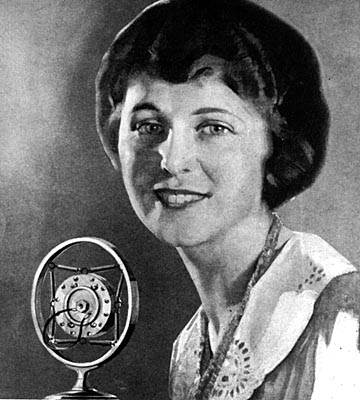
Original Betty Crocker image for radio show, 1927 courtesy General Mills archives
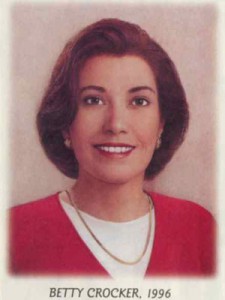
Latest reincarnation
Watch this vintage Betty Crocker cake commercial : The men sure love it – and so will your bridge club!
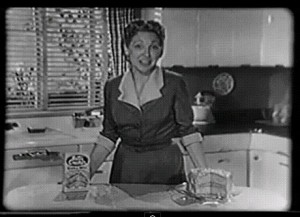
http://www.youtube.com/watch?v=WcrCyypYEuI
GIVEAWAY!
For our very first ever giveaway we are offering up two very stylish, vintage inspired aprons made by our dear friend, and Susan’s personal apron supplier- Other Susan. We picked out the fabrics, and Other Susan did the rest.

First prize: Two-in-one, custom- made, vintage inspired apron.
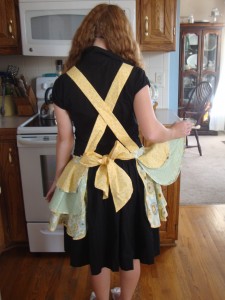
Back

Work it, Kitten, work it! ( Same apron, now a hostess style)

Second Prize! Custom, full practical apron (This is the style Susan runs around her neighborhood wearing. *sigh*)

Close up of main fabrics.
Yes, the apron is a symbol of some less than feminist qualities—but dang it! These are cute and- in the words of Beckett when she saw these pictures, “That’s being a true chick! Do what you do and damn the rest!”
Want one? Post a comment to THIS shownote, telling us who your favorite TV Mom is (any era). On October 30, 2011-mid dayish- we will do a random drawing of the names and pick two winners. Make sure that the email you supply us with when you post your comment (it does not appear on posted comments) is one that you monitor so that we can get the shipping details from the winners. Good luck!
(Here is a link to Other Susan’s Etsy shop, From Pieces.http://www.etsy.com/shop/FromPieces She does custom work as well as featuring some pieces in her shop.)
Before we leave the 1950’s behind, thank you for listening! We are nominated in the Education category for the 2011 People’s Choice Podcast Awards! If you would like to vote, and it is before October 27th, 2011–click this link! Thank you! http://podcastawards.com/
by The History Chicks | Oct 8, 2011 | Biography Episode, Episode, Podcasts
Once a season we take a slight break from reality and sit down for a chat about a fictional woman. This season we chose not one, but a group: The 50’s TV Mom – and their slightly more real counterparts, the 50’s suburbanite.
That’s right, what better way to embrace our modern womanhood, than to take a serious look at a stereotypical, unobtainable-to mere-mortals, obedient, white, heterosexual wife?
WOOT! Fire up the keyboard and get those letters of protest going!
(Ok, really? Don’t. Yikes… Thank you!)
DISCLAIMER: We get a bit, um, goofy in this episode. If you are looking for serious, somber history- look away. We present facts of course, but our usual speculation and lighthearted chatter is upped. Big time.
We DO look at this topic from a historical point of view, but first our exhaustive research of the women had to be undertaken. We narrowed our focus down to several whom we thought were true representatives of the genre.
(And we use words like “genre” to give the illusion that this is more brainy that it really is. We watched A LOT of TV)
Harriet Nelson (The Adventures of Ozzie and Harriet)
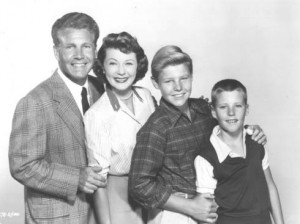
The Adventures of Ozzie and Harriet
Donna Stone (The Donna Reed Show)

Lucy Ricardo (I love Lucy, Lucille Ball)
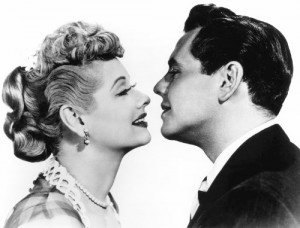
I Love Lucy
June Cleaver (Leave it to Beaver, Barbara Billingsley)
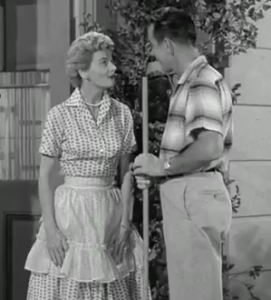
Leave it to Beaver
We touch on characters from other shows-Make Room for Daddy, Father Knows Best, The Dick van Dyke show- but we felt that these gave the best example of the ideals that the 50’s stereotypical housewife possessed.
We are, after all, all about history, so we lay the scene that created an environment to let such a symbol of femininity grow to idol status in American society. We talk the Great Depression and WWII because that is the background of the Moms of the 50’s. We discuss the economy, the sociological and economic changes in the country, throw out some statistics and paint a picture of the expectations and role of women in society.
Then we get to the giggly part and talk about the stereotypical woman herself. What her life was like vs the real life of the woman she represented during this era. We talk about both the dark and the light sides of this women’s life. We talk about the foods, the appliances, and the conveniences of the time.

And we talk fashion because we like retro fashion. A lot.
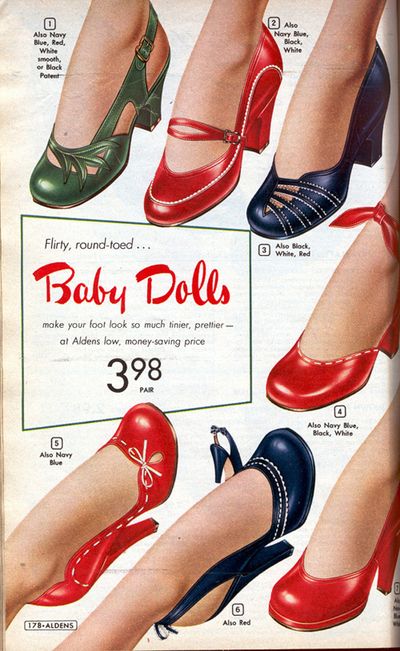
*sigh*, but the 1950's TV Housewife is a part of the American culture, a step in the path of progress to who we are today, and should be looked at and discussed.
Bottom line: The 1950’s Television Housewife was a part of the American culture and a step in the path to where women are today.
Because we are off of our usual factual woman topic ( and possibly still riding a banana bread buzz) we will also stray from our usual methods….and will actually have * trumpets please* a giveaway!! Stay tuned for details!

Stay tuned to whatever screen you are watching at this very minute for giveaway details!
Time Travel With The History Chicks
Right at the top of this list, we recommend this blog, Jen But Never Jenn. She conducted a 50’s Housewife Experiment that both amused and fascinated us. (Susan so much so that she decided to conduct her own, in a total rip off way. We contacted Jen and she was cool with it. More on this in an upcoming minicast) http://www.jenbutneverjenn.com/2010/05/welcome-to-50s-housewife-experiment.html
If you are enamored with the era, there is a blog and messageboard for that! Kitchy and fun! http://www.theapronrevolution.com/forum7.html
We Lol’d repeatedly at The Gallery of Regrettable Food: http://lileks.com/institute/gallery/
The link to the Striving Wife (the one that Susan could not remember) is here. Written by, and for, women who think the 50’s Housewife ideal is spot on. This is just one post of many on a blog devoted to the life of a Christian wife. The posts are written with respect and a very deep faith. http://thestrivingwife.com/what-makes-a-good-wife-the-1950s-ideal-vs-modern-day/
And we watched HOURS of old TV episodes Hulu.com – Father Knows Best, I love Lucy, Leave it to Beaver, The Donna Reed Show and The Dick Van Dyke show.
Speaking of Donna Reed, The Donna Reed Foundation for the Performing Arts, a museum in Denison IA dedicated to her memory and work . Visit them online http://www.donnareed.org/html/templates/dr_section.php?dr_section=main
And here is a link to those Maidenform ads that cracked Beckett up: http://www.tressugar.com/Dreaming-Shirtless-Look-Back-Maidenform-Bra-Ads-3174297?
We KNOW you love your books! We recommend:
The Way Things never were by Norman Finklestein
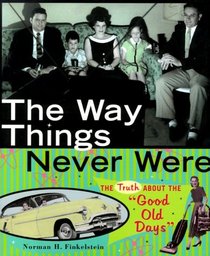
Something from the Oven, by Laura Shapiro
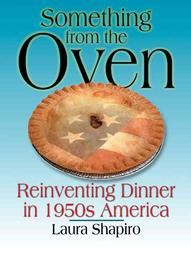
And finally, the one that we loved, not just for this episode, but for many eras: The History of the Wife by Marilyn Yalum
 As always, music comes courtesy of Music Alley, visit them at music.mevio.com
As always, music comes courtesy of Music Alley, visit them at music.mevio.com


































